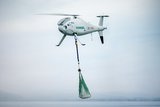US Army Awards Lockheed Martin $133 Million to Provide Persistent Threat Detection Aerostat Systems
Lockheed Martin recently received a $133 million award to provide the US Army with eight additional Persistent Threat Detection Systems (PTDS) to support coalition forces.
A tethered aerostat-based system in use by the Army since 2004, PTDS is equipped with multi-mission sensors to provide long endurance intelligence, surveillance, reconnaissance and communications in support of coalition forces. Nine systems are currently deployed, and the additional eight will be provided over the next 11 months.
“PTDS is providing our troops in the field with real-time surveillance and valuable intelligence information,” said Stephanie Hill, vice president of Lockheed Martin’s Integrated Defense Technologies business. “These affordable and reliable systems demonstrate the increasing importance of rapidly deployable lighter-than-air platforms to today’s warfighters.”
Filled with helium, aerostats and other lighter-than-air systems provide low-cost, long-endurance communications and surveillance capabilities not possible with other types of aircraft. Attached by a high-strength tether to a re-locatable mooring system, aerostats can stay continuously aloft for weeks, carrying different types of surveillance equipment to conduct multiple missions.
More from Uncrewed Vehicles
-
Jammer resistant drone designs spark search for countermeasures
The Russia-Ukraine conflict has driven another stage of evolution for drones and the counter measures to defend against them.
-
![L3Harris launches Amorphous software for control of uncrewed platforms]()
L3Harris launches Amorphous software for control of uncrewed platforms
The new Amorphous software is a universal controller that would allow a single operator to control a swarm of “thousands” of uncrewed systems, from drones to underwater platforms.
-
ideaForge unveils new UAVs at Aero India 2025
India UAV supplier ideaForge has launched the Netra 5 and Switch V2 drones at Aero India 2025, boasting of enhanced endurance, AI-driven autonomy and improved operational capabilities.
-
![Shaping the future of defence: What 2025 holds for the global drone market]()
Shaping the future of defence: What 2025 holds for the global drone market
The UAV market is experiencing unprecedented growth, with innovations in technology and battlefield applications driving demand across military sectors. From the battlefields of Ukraine to NATO exercises and beyond, drones are transforming how wars are fought and supported.
-
![Maris-Tech confirms customers signing up for Jupiter Drones codec and AI-powered system]()
Maris-Tech confirms customers signing up for Jupiter Drones codec and AI-powered system
Launched at AUSA in October, the company’s multi-stream video codec is attempting to bring a new lease of life to drone technology through its AI accelerator.
-
![AUSA 2024: Quantum-Systems targets big 2025 with UAS developments]()
AUSA 2024: Quantum-Systems targets big 2025 with UAS developments
Quantum-Systems has been upgrading its UAS family, with new versions of the Vector, Reliant and Twister drones set for release throughout 2025.
























